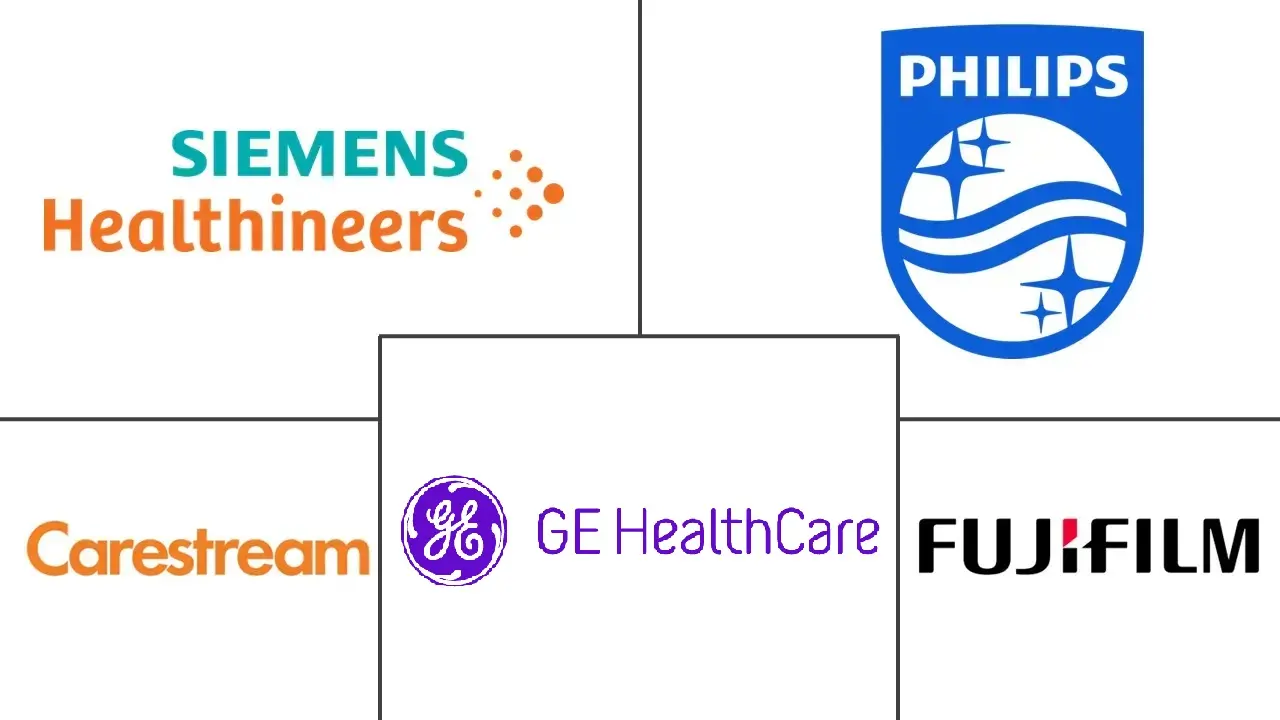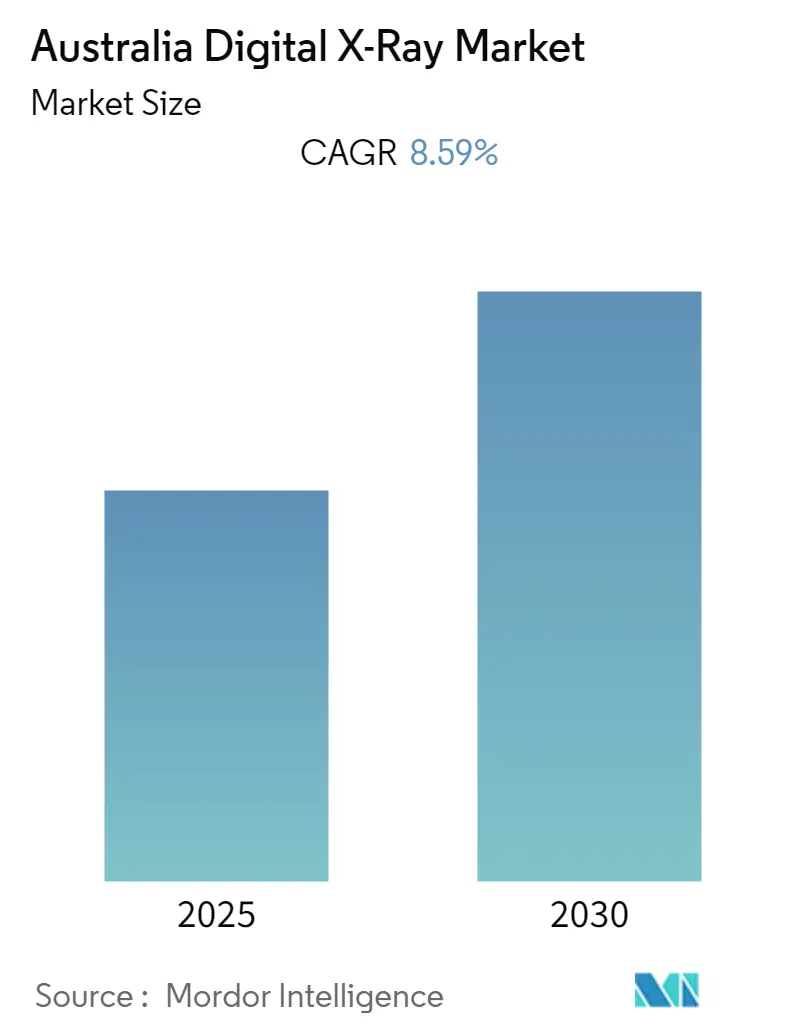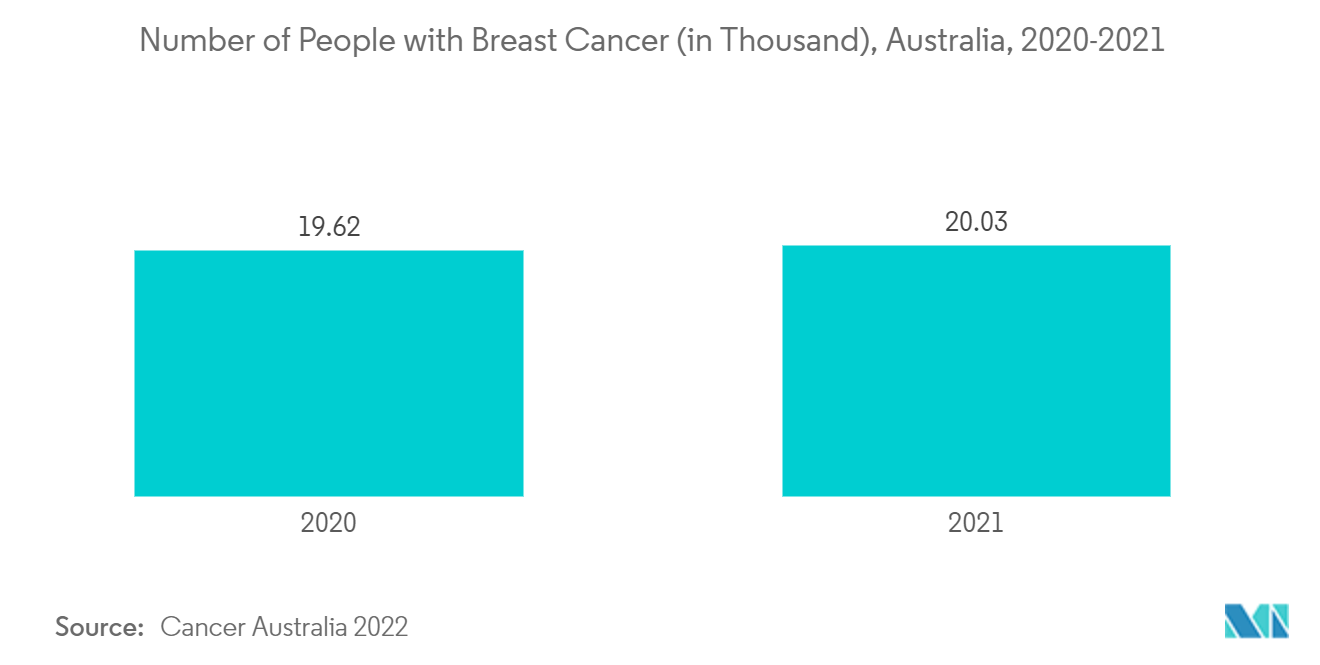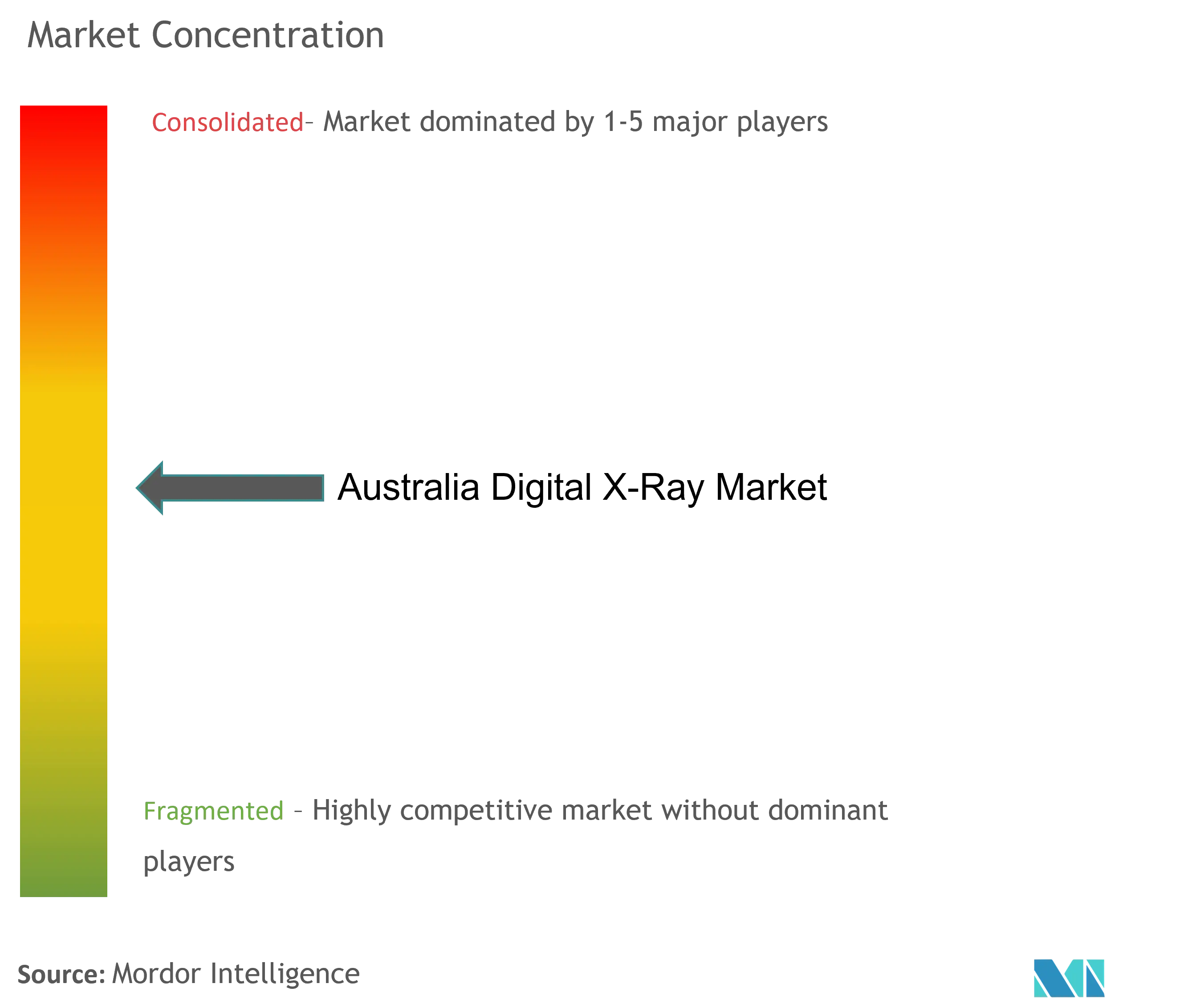Australia Digital X-Ray Market Analysis
The Australia Digital X-Ray Market is expected to register a CAGR of 8.59% during the forecast period.
The COVID-19 pandemic resulted in disruptions to the supply chain, delayed installations, reduced services and financial challenges for healthcare providers, which impacted the digital X-ray market in Australia. For instance, according to an article published by MDPI in January 2023, the availability of diagnostic tests, such as diagnostic imaging, both clinically and based on research, for conditions unrelated to cancer impacted diagnostics during the pandemic. In Australia, the first wave of the COVID-19 pandemic was associated with a significant reduction in total available imaging services, with general radiology, ultrasound, and magnetic resonance imaging (MRI) services. Hence, there was a decrease in digital X-ray demand during the initial phase of the pandemic. However, currently, as there is better access to healthcare facilities compared to the initial pandemic phase due to the lockdown, the market is expected to gain its growth pace in the post-pandemic period.
Factors such as the increasing prevalence of chronic diseases are expected to drive market growth. Chronic diseases such as cardiovascular disease, respiratory disease, and neurological conditions often require regular imaging for diagnosis, treatment planning, and monitoring of disease progression. As the prevalence of chronic diseases continues to rise, the demand for efficient and effective diagnostic tools like digital X-ray systems will increase. For instance, according to the Australian Institute of Health and Welfare update in February 2023, indigenous Australians living in remote areas reported higher rates of cardiovascular disease, with 18%, compared with those in non-remote areas, which is 15%. Across jurisdictions, Indigenous Australians reporting cardiovascular disease ranged between 13% in South Australia and 18% in the Northern Territory. Thus, with a high burden of cardiovascular disease, the demand for its monitoring and diagnosis increases, thereby driving market growth.
Furthermore, the increasing prevalence of cancer is expected to increase the demand for digital X-rays as cancer patients require regular monitoring and diagnosis to track tumour progression. For instance, National Cancer Statistics in December 2021 estimated that 151,000 Australians were diagnosed with cancer in 2021, over 400 per day, and over 1 million Australians live with cancer. Thus, with the high burden of cancer cases, the demand for monitoring cancer progression through digital X-rays increases, driving market growth over the forecast period.
Additionally, the government's initiatives to improve the healthcare infrastructure align with their goals of enhancing healthcare delivery, reducing healthcare costs, and improving patient outcomes. Governments will likely create a favourable environment for digital X-ray market growth by encouraging the transition to digital X-ray systems. For instance, in April 2022, the Australian Government installed four 3D X-ray units at the Melbourne and Sydney international mail gateway facilities. The department received funding for three more 3D X-ray units to be installed. Thus, funding from the government to install 3D X-ray units led to increased accessibility for digital X-rays, thereby driving market growth.
Thus, factors such as the increasing prevalence of chronic diseases and government funding increase are expected to boost market growth over the forecast period. However, the high equipment cost is expected to impede market growth over the forecast period.
Australia Digital X-Ray Market Trends
Cancer Segment is Expected to Hold a Significant Market Share Over the Forecast Period
Cancer is a complex disease characterised by uncontrolled cell growth and the ability of these abnormal cells to invade and spread to other parts of the body. Digital X-rays capture detailed images of the body's internal structures, allowing medical professionals to detect abnormalities such as tumours, evaluate their size and location, and monitor their progression or response to treatment. The significant factors affecting the market's growth include the rising incidence of cancer and the increasing geriatric population. For instance, according to the Cancer Australia update in 2022, Australia's estimated age-standardized cancer incidence rate was 507 cases per 100,000 people (575 for men and 449 for women) in 2021. Also, as per the above source, the incidence rate for cancer was expected to increase with age, the highest for those aged 85-89.
Furthermore, according to the Australian Institute of Health and Welfare update in December 2021, the percentage of older Australians in the population is set to increase to approximately 20.7% in 2066. Thus, with an increase in the geriatric population, the incidence of cancer cases also increases, which is expected to increase the need for monitoring cancer progression, thereby driving segmental growth.
Additionally, various initiatives taken by the government, such as funding to promote cancer diagnosis, are expected to boost the market's growth during the forecast period. For instance, in August 2021, the National Breast Cancer Foundation (NBCF) reported a USD 3 million contribution to a new USD 5 million co-investment with the University of Sydney in its first 10-Year Chair in Breast Cancer Prevention. Significant investment in prevention research has been awarded to address several areas in screening to reduce the growing incidence of breast cancer. Such an initiative is expected to increase the demand for digital X-rays, thereby driving segmental growth.
Hence, due to the factors such as the rising incidence of cancer and various initiatives taken by the government, the segment is anticipated to witness growth during the forecast period.
Computed Radiography Segment is Expected to Hold a Significant Market Share Over the Forecast Period
Computed Radiography (CR) is a method to generate digital images in X-ray radiography that uses photo-stimulated luminescence to store the X-ray exposure into a latent image that is then digitised. Factors propelling the segment's growth include the advantage of computed radiography, the increasing ageing population and technological advancements. For instance, per the University of New South Wales report published in August 2022, Australia's population aged 85 and above is projected to increase by 140% from 534,000 in 2021 to 1.28 million by 2041. Thus, the demand for computed radiography is expected to increase with an increased geriatric population, leading to segmental growth.
Furthermore, according to the Australian Institute of Health and Welfare update in January 2023, 80% of older Australians (aged 65 and over) have at least one selected chronic health condition, and 28% have three or more. Thus, with an increase in the chronic condition, the demand for its diagnosis increases, increasing the need for computed radiography, thereby driving segmental growth.
Additionally, the cost of setting up a computed radiography system is much less than a direct radiography system. Hence, the companies are actively involved in strategies, developments, and collaborations to expand their footprint, which is expected to drive segmental growth. For instance, in October 2021, Pearl, the leader in AI solutions for efficiency, accuracy, and consistency in dental care, reported that it had received authorisation to introduce its Second Opinion AI solution to the Australian and New Zealand dental markets. The clearances from Australia's Therapeutic Goods Administration (TGA) and New Zealand's Medical Devices Safety Authority (MEDSAFE) were received for use as an assistive tool in dental radiology.
Thus, factors such as the increasing ageing population and technological advancements will likely contribute to the segment's growth over the analysis period.
Australia Digital X-Ray Industry Overview
Australia digital X-ray market is moderately competitive and consists of several major players. Some of the key companies in the market are Carestream Health, Siemens Healthineers AG, GE Healthcare, Fujifilm Holdings Corporation, and Koninklijke Philips NV, among others.
Australia Digital X-Ray Market Leaders
-
Carestream Health
-
GE Healthcare
-
Siemens Healthineers AG
-
Fujifilm Holdings Corporation
-
Koninklijke Philips NV
- *Disclaimer: Major Players sorted in no particular order
Australia Digital X-Ray Market News
- In May 2023, the Government of the Australian Capital Territory invested USD 6 million to establish the Weston Creek Imaging Service, providing Canberrans with public medical imaging accessible outside a hospital by opening a Medical Imaging Service.
- In April 2022, the Mobile health clinic service in Australia received a funding commitment of USD 17.2 million from the Federal Government. The funding will provide services spanning cardiology, endocrinology, sleep medicine, geriatric medicine, immunology, neurology, and CT and X-ray imaging.
Australia Digital X-Ray Industry Segmentation
As per the scope of this report, digital X-ray or digital radiography is a form of X-ray imaging where digital X-ray sensors are used instead of traditional photographic films. This has the added advantage of time efficiency and the ability to transfer images digitally and enhance them for better visibility. This method bypasses the chemical processing of photographic films. Digital X-ray imaging has high demand, as it requires less radiation exposure compared to traditional X-rays. Australia Digital X-Ray Market is Segmented by Application (Orthopedic, Cancer, Dental, Cardiovascular, and Other Applications), Technology (Computed Radiography and Direct Radiography), Portability (Fixed Systems and Portable Systems), and End User (Hospitals, Diagnostic Centers, and Other End Users). The report offers the value (in USD million) for the above segments.
| By Application | Orthopedic |
| Cancer | |
| Dental | |
| Cardiovascular | |
| Other Applications | |
| By Technology | Computed Radiography |
| Direct Radiography | |
| By Portability | Fixed Systems |
| Portable Systems | |
| By End User | Hospitals |
| Diagnostic Centers | |
| Other End Users |
Australia Digital X-Ray Market Research FAQs
What is the current Australia Digital X-Ray Market size?
The Australia Digital X-Ray Market is projected to register a CAGR of 8.59% during the forecast period (2025-2030)
Who are the key players in Australia Digital X-Ray Market?
Carestream Health, GE Healthcare, Siemens Healthineers AG, Fujifilm Holdings Corporation and Koninklijke Philips NV are the major companies operating in the Australia Digital X-Ray Market.
What years does this Australia Digital X-Ray Market cover?
The report covers the Australia Digital X-Ray Market historical market size for years: 2019, 2020, 2021, 2022, 2023 and 2024. The report also forecasts the Australia Digital X-Ray Market size for years: 2025, 2026, 2027, 2028, 2029 and 2030.
Our Best Selling Reports
Australia Digital X-Ray Industry Report
Statistics for the 2025 Australia Digital X-Ray market share, size and revenue growth rate, created by Mordor Intelligence™ Industry Reports. Australia Digital X-Ray analysis includes a market forecast outlook for 2025 to 2030 and historical overview. Get a sample of this industry analysis as a free report PDF download.







